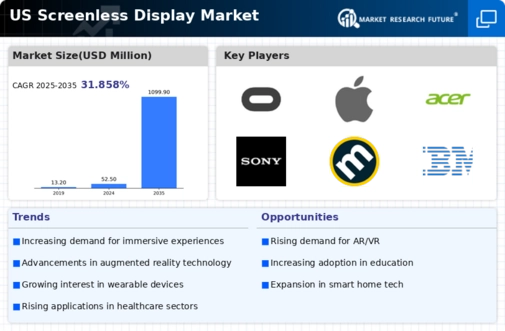Growing Demand for Portable Devices
The increasing demand for portable devices is a significant driver for the screenless display market. Consumers are seeking lightweight and compact solutions that offer convenience without compromising functionality. This trend is particularly evident in the mobile computing sector, where traditional screens can be cumbersome. The market for portable devices is expected to reach $150 billion by 2026, with a notable portion attributed to screenless technologies. As manufacturers respond to consumer preferences, the screenless display market is likely to see enhanced innovation and product offerings, catering to the needs of on-the-go users.
Enhanced User Experience Expectations
In the screenless display market, enhanced user experience expectations are driving innovation and adoption. Consumers increasingly demand intuitive interfaces and seamless interactions with technology. This shift is prompting companies to explore screenless solutions that provide immersive experiences, such as gesture recognition and voice commands. As user experience becomes a focal point, the market is projected to grow by 20% annually through 2028. Companies that prioritize user-centric design in their screenless display offerings are likely to gain a competitive edge, indicating a shift in market dynamics.
Advancements in Holographic Technology
The screenless display market is experiencing a surge due to advancements in holographic technology. Innovations in this field enable the creation of three-dimensional images that can be viewed without traditional screens. This technology is particularly appealing in sectors such as entertainment and advertising, where immersive experiences are paramount. The market for holographic displays is projected to grow at a CAGR of 25% from 2025 to 2030, indicating a robust demand for screenless solutions. As companies invest in research and development, the potential applications of holography in the screenless display market are expanding, suggesting a transformative impact on how visual information is consumed.
Rising Adoption in Healthcare Applications
The screenless display market is witnessing rising adoption in healthcare applications. This trend is driven by the need for innovative solutions in patient care and medical training.. Screenless displays can facilitate hands-free interactions, allowing healthcare professionals to access critical information without diverting their attention from patients. The healthcare technology market is projected to grow to $500 billion by 2027, with a significant portion attributed to screenless technologies. This trend indicates a growing recognition of the benefits that screenless displays can offer in enhancing efficiency and improving patient outcomes.
Increased Investment in AR and VR Technologies
The screenless display market is benefiting from increased investment in augmented reality (AR) and virtual reality (VR) technologies. As businesses recognize the potential of AR and VR to enhance training, marketing, and customer engagement, funding for these technologies is on the rise. In 2025, investments in AR and VR are expected to exceed $30 billion in the US alone. This influx of capital is likely to accelerate the development of screenless display solutions that integrate with AR and VR applications, suggesting a promising future for the market.























Leave a Comment